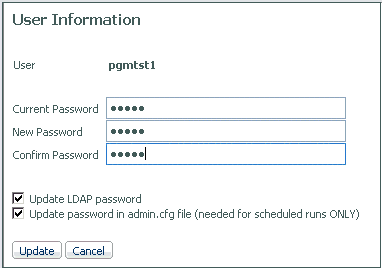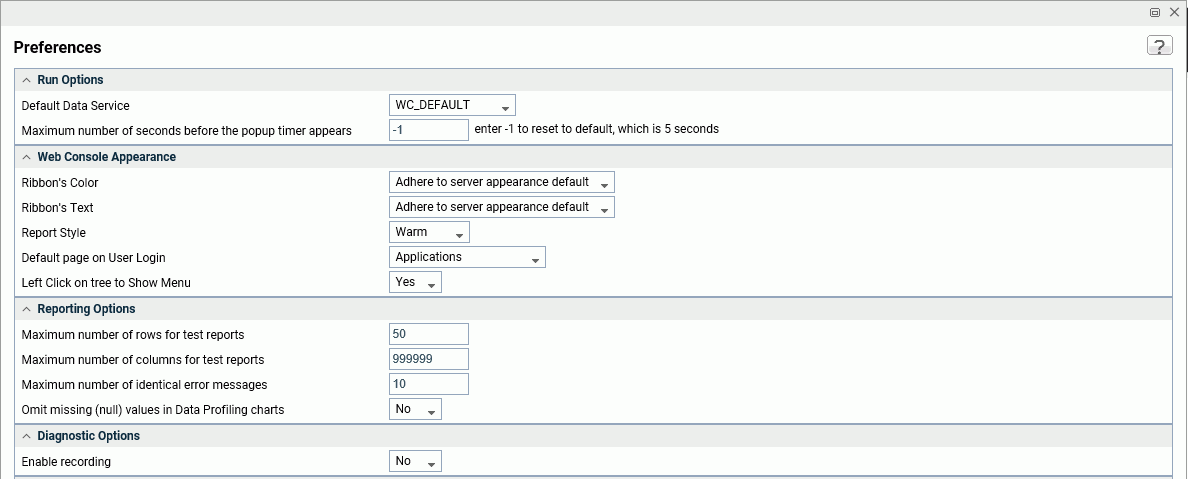Menu Options
|
Topics: |
Each Console page provides options on the ribbon and the click and right-click options from the top node of its tree.
To minimize the ribbon, click Minimize the Ribbon from the ribbon icon on the right portion of the page. To show the ribbon, click Minimize the Ribbon again.
The following options are available on the right portion of the page.
Ribbon Options
The ribbon icon on the top right of the page provides the following options:
- Minimize the Ribbon. This option toggles the ribbon on and off.
- Show Icon Text. This option toggles the text describing each icon on the ribbon on and off.
User Menu Options
The following options are available from the User menu on the right portion of the page.
End Current Session or Sign Out
This option signs the user out and opens the Web Console Sign in page.
My Console
These options provide users with functionality that supports the tasks they are authorized to perform. The options that a user has under My Console depend on the user role and general privileges assigned to the user.
In the descriptions that follow, each option applies to the user who is connected to the current Web Console session.
Show My General Privileges. Shows the privileges set by the Server Administrator for the user who is logged in to the current Web Console session. Privileges can be customized for each role, group, or user. See Consequences for Files Under the EDAHOME/EDACONF Hierarchy, for details on the information supplied on the General Privileges pane.
Change My Password. Enables you to specify a new password to replace your current password. When you click this console option, the dialog box shown in the following image is displayed. Supply the requested information, and click Update.
Note: The LDAP security mode also allows you to change your password in the LDAP directory.

Manage My Agents. Enables you to monitor and manage Data Service Agents, based on your role and privileges. For example, if you are a Basic user, by default you can monitor and manage your own agents (that is, the agents that match your user ID). If granted the applicable privileges, you can also monitor, or monitor and manage, the agents of the other users in your group (that is, users with the same group ID).
When you click Manage My Agents, a Performance Report for Data Service Agents is displayed, showing statistics for the agents that you are authorized to see. You can customize and filter the report to display only those statistics that you are interested in.
To determine your privileges, click Show General Privileges. See Consequences for Files Under the EDAHOME/EDACONF Hierarchy for details on the information supplied on the General Privileges pane.
Save My Last Report. Saves the last report (procedure) that you ran with the values that you chose for the amper variables. The report is saved as a new, separate procedure. You can run the saved report without having to manually supply the values for the amper variables as you did before.
When you click this console option, you can select for the application directory in which to save the report and enter a file name for the report.
Edit My Profile. Enables you to make changes to your current user profile settings.
Login Info
This option displays user login status and browser-related information. Login status information includes user name, group, and role, location of all profiles (user, group, and role) if they exist, and type of authentication (explicit or cookie). HTTP information reflects the properties of the current browser session, for example, the cookie.
Enable Traces
This option enables traces to provide diagnostics assistance. For more information, see Tracing Server Activity.
Clear Session Log
This option deletes all lines from the session log.
Session Log
This option opens the Session Log window, which provides a record of server configuration and activity.
Export for Printing
If a report, such as a Data Services Agents report, is open in the Web Console, clicking this option opens the report in a web browser.
Preferences
This option enables you to indicate preferences for Run Options, Web Console Appearance, Reporting Options, and Diagnostic Options, as shown in the following image.

Run Options are:
- Default Data Service The choices for Default Data Service are DEFAULT, WF_DEFAULT, SCHED_DEFAULT, and DFM_DEFAULT.
- Maximum number of seconds before the popup timer appears
The Web Console Appearance options are:
- Ribbon's Color. The choices are Adhere to server appearance default, skyblue on white, gray on white, white on black.
- Ribbon's Text. The choices are Adhere to server appearance default, Display All, Icon Test Only, Group Text Only, None.
- Report Style. The choices are Warm, Standard, and Flat. The default is Warm.
- Default page on User Login. The choices are Applications, Adapters, Resource Management, Workspace/Monitor, Access Control, Scalability, and Upload Wizard. The default is Applications.
- Left Click on tree to Show Menu. The choices are Yes and No. The default is Yes.
The Reporting Options are:
- Maximum number of rows for test reports. The default is 50.
- Maximum number of columns for test reports. The default is 999,999.
- Maximum number of identical error messages. The default is 10.
- Omit missing (null) values in Data Profiling charts. The choices are Yes and No. The default is No.
The Diagnostic Options are:
- Enable recording for diagnostic. The choices are Yes and No. The default is No.
Indicate your preferences, and click Update.
Language
This option controls the language in which the Web Console is displayed. For example, all menu options are translated into the selected language. This console option is available if the server is configured for National Language Support (NLS).
| WebFOCUS | |
|
Feedback |